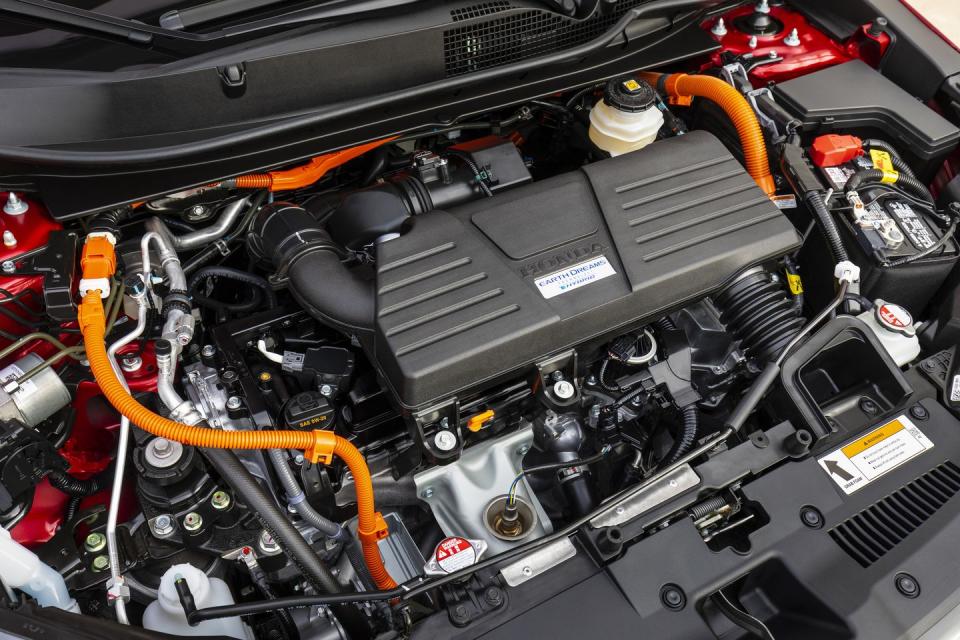Tested: 2020 Honda CR-V Hybrid Can't Match the Toyota RAV4 Hybrid's Fuel Economy
6/9/20 UPDATE: This review has been updated with test results.
Although Honda began selling its CR-V hybrid in Europe and China more than a year ago, the hybrid compact crossover is new to the United States for the 2020 model year. The hybrid CR-V is brand's first electrified SUV in the U.S., and it's expected to become its best-selling hybrid. That shouldn't be too difficult, since Honda's hybrid lineup stateside consists of a sedan and two hatchbacks: the Accord, the Insight, and the Clarity plug-in hybrid. Between those three, Honda moved fewer than 59,000 hybrids last year, but the CR-V hybrid should bump that number up considerably, given that it's based on Honda's top-selling vehicle. And the gas-electric version of the CR-V is well executed, bringing refinement, competitive pricing, and impressive fuel economy to a rapidly expanding segment.
Familiar Hybrid Tech
The CR-V hybrid is clearly aimed at Toyota's best-selling hybrid, the RAV4. Last year, about 92,000 RAV4 hybrids were sold. In the CR-V hybrid, Honda uses a two-motor hybrid system that we've praised in the Accord Hybrid but with a few tuning changes to smooth out its operation and improve efficiency, as well as the addition of all-wheel drive. It combines an Atkinson-cycle 2.0-liter inline-four with two motor-generators and a relatively tiny 1.4-kWh lithium-ion battery pack. Despite the battery's small size, the hybrid components add a sizeable 201 pounds to the CR-V hybrid's curb weight versus an equivalent standard model.

The CR-V is Honda's first hybrid to have all-wheel drive. Unlike Toyota's hybrid all-wheel-drive system, which puts an electric motor in the rear end to assist the otherwise front-drive RAV4, the CR-V uses the same system that's in the non-hybrid. Which is to say, there's a clutch that engages the rear axle when the system predicts or detects slippage or when sending torque to the rear axle is otherwise advantageous, such as under hard acceleration or when ascending a steep grade.
Honda also tweaked the hybrid's naturally aspirated 2.0-liter inline-four. This Atkinson-cycle engine uses the higher compression ratio of the Accord Hybrid (13.5:1) and a new exhaust-gas recirculation system. The system's combined outputs of 212 horsepower and 232 lb-ft of torque are the same as the Accord hybrid, too. The hybrid could be considered a performance version of the CR-V, since it makes more power than the 190 horsepower and 179 lb-ft you get from the standard turbocharged 1.5-liter four. For comparison, the RAV4 Hybrid makes 219 horsepower, and the Ford Escape hybrid has 209 ponies.

As in the Accord, the four-cylinder engine is primarily used as a generator of electricity. There are conditions when a clutch engages and the four-cylinder drives the car directly (low load, highway cruising) or in collaboration with the drive motor (maximum acceleration). The juice generated by the engine is usually sent to the electric motors to move the vehicle, but it can also be diverted to charge the battery pack. There is an electric-only EV mode, but the small battery limits the range to a mile or two, and even moderate throttle inputs cause the engine to fire up.
Regenerative braking recoups some electricity by using the electric motors as generators when decelerating. The amount of regeneration, which affects how quickly the CR-V slows when you lift off the accelerator, can be adjusted in four increments via the steering wheel's paddle shifters. Only the Sport drive mode allows you to lock in a chosen amount of regen. Keep the vehicle in its standard drive mode, and the system will always revert back to its default least-aggressive setting after a few seconds, which means that stronger degrees of regen must be manually selected every time the vehicle decelerates. This can be tiresome in stop-and-go traffic, and even the most-aggressive mode still requires you to apply the brakes to come to a complete stop.
A Better Driving Experience
The hybrid's battery placement beneath the CR-V's rear cargo floor eliminates the spare tire, and the load floor can no longer be lowered to expand its capacity. While Honda didn't apply any meaningful weight-saving measures to the hybrid, it did firm up the suspension to better manage the added mass. This helps lend the CR-V hybrid a solid, substantial feel on the road. Its ride remains compliant, even on the Touring's standard 19-inch wheels. Our test vehicle exhibited good stability and secure road manners, although its 173-foot stop from 70 mph is eight feet longer than the lighter non-hybrid model's. The standard CR-V's 0.85 g of lateral grip around the skidpad also dropped to 0.80 g for the hybrid. And those penalties aren't due to low-rolling-resistance tires, since the electrified CR-V rides on the same Continental CrossContact LX Sport rubber as the non-hybrid Touring we tested. That leaves those extra 201 pounds as the culprit.


 Yahoo Autos
Yahoo Autos 